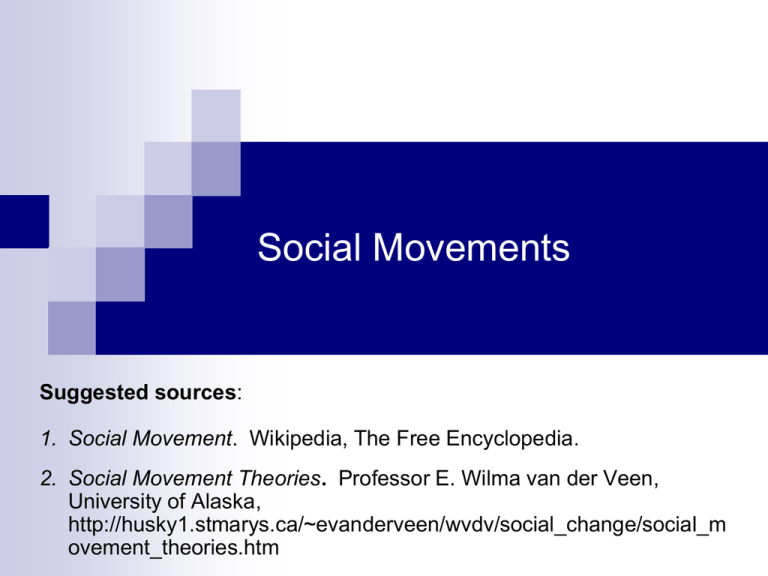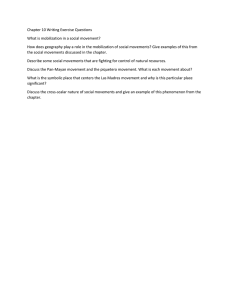Social Movements
advertisement

Social Movements Suggested sources: 1. Social Movement. Wikipedia, The Free Encyclopedia. 2. Social Movement Theories. Professor E. Wilma van der Veen, University of Alaska, http://husky1.stmarys.ca/~evanderveen/wvdv/social_change/social_m ovement_theories.htm Social Movement: Description A social movement is a type of group action focused on bringing about social change. Social movements are a series of contentious performances, displays and campaigns, by which ordinary people make collective claims on others (C. Tilly). Social movements typically are thought of as long-lasting events that attract many participants with common goals for changing a specific structure of society. Social movements typically attract persons with different objectives for creating change, varying from peaceful demonstrations to violent confrontations. Social movements typically have many sub-groups with somewhat different visions of structural change. Social Movement: Scope Reform movements Movements dedicated to changing some norms, usually legal ones. Legal strikes by union workers for better pay and benefits. Green movement advocating stricter environmental laws. Appeals for societal restrictions on smoking, alcohol abuse, pornography. Appeals for repeal of Roe vs. Wade Supreme Court decision, permitting abortion. Appeals for enforcement of existing laws (e.g., deportation of illegal workers). Appeals for new laws (e.g., same-sex marriages). Social Movement: Scope Radical movements Movements dedicated to changing value systems. Appeals to make fundamental changes. American Civil Rights movement. Polish Solidarity movement. Anti-Apartheid movement in South Africa. Social Movement: Functionalist Theories The Adaptive Perspective Movements arise in response to widely-recognized need for change in the structure of society. Movements seek to improve the functioning of society to respond to changes in the external environment. Citizens share a sense of anxiety and frustration over existing institutions. Citizens are mainly united in defining goals for a new structure to society. Movements are functional in changing institutions to meet challenges of a new environment, training new leaders, and engendering social cohesion. Movements are dysfunctional in creating transitional disruption in existing institutions and temporarily displacing individuals from existing roles. Social Movement: Functionalist Theories Value-Added Theory Emphasizes ongoing interaction between social movements and society. That is, it is less “reaction to changing environment” and more “constant changes to society as the environment changes.” Six essential conditions needed for change. 1. Structural conduciveness: Societal institutions and leaders are open to change and new ideas. 2. Structural strains: Recognition of strain in institutions and the need for change. 3. Development of a generalized belief system regarding needed change and viable alternatives. 4. Precipitating events. Triggering events to mobilize already existing felt need for change. Social Movement: Functionalist Theories Value-Added Theory Six essential conditions needed for change. 5. Mobilization of participants for change. This mobilization can vary from non-violent to violent interest groups with similar goals for change. 6. Operation of social control. Counter movements, government action to slow or stop change, different forms of public discourse and action. Social Movement: Conflict Theories An Activist Perspective Interest groups attempt to gain power, produce social reforms, gain entry into established structures of society. The power elite will attempt to prevent such movements from occurring. Less powerful segments must mobilize their resources to successfully compete against more powerful segments of society. The “we” vs. “they” perspective of competing interest groups is more likely to engender antagonist public discourse and violence. Social Movement: Conflict Theories Mobilization Process Building a power base among sympathetic political and economic elites. Recruiting new members with similar beliefs. Motivating persons to action. Removing barriers to participation. Creating a collective identity to retain existing members. Social Movement: Conflict Theories Political Process Theory Focus on windows of opportunity for social change. Addresses the issue of timing of social movements and provides explanations for the processes of social movements. 1. Growth of political pluralism (competition among two or more political parties with fairly equal power). 2. Elite disunity, internal fragmentation of the elite, disunity among the prevailing powerful segments. 3. Broadened access to power gaps. 4. Elites reach out to other interest groups to gain needed majorities for control of power. 5. New opportunities for new groups. Social Movement: Conflict Theories New Movement Theory Focus upon emerging culture, ideology, generalized beliefs, and values in shaping social change and development. Groups attempt to sustain and expand their “lifespace,” their hold on the ability to define proper values. Focus on ethics and morality and who defines what is ethical and moral. Complex agendas emerge as groups seek to expand their values to a broad spectrum of life. Value-oriented groups do not see the government as an ally. Typified by political righteousness, agents of cultural revolution. Social Movements Summary The Future: Live it or Live with It!

